| Author |
Message |
|
Myles Mulkey
|
 Posted: Fri 05 Feb, 2010 5:16 am Post subject: Posted: Fri 05 Feb, 2010 5:16 am Post subject: |
 |
|
| Christian Böhling wrote: | | the combs found in Illerup with that broad and high grip-plates and the one-piece combs are of scandinavian origin, while the smaller ones assembled with more parts are denish or northern german, as Elks were not living there. |
Do you have any examples of what the continental Danish and German combs looked like? Were they similar to the thinner Viking combs you showed?
|
|
  |
 |
|
Christian Böhling
Industry Professional
|
|
   |
 |
|
Myles Mulkey
|
 Posted: Fri 19 Feb, 2010 6:07 am Post subject: Posted: Fri 19 Feb, 2010 6:07 am Post subject: |
 |
|
| Christian Böhling wrote: | Hi Peter,
you are absolutely right! The economic use of material that the original material show us was impressing me much, when nowadays modern craftsmen say "forge thick - grind thin", they tried to use all material which was availlable to "forge close to the end...." So I formed the grip out of the full material when most modern craftsmen would do it by cutting it out...
But what really impresses me is what I have seen through the finds of Illerup Ådal, I have been to Moesgaard several times and found blades which were finished so acourate - we both know the octagonal blade from that site, we have had it here at our museum where I am employed in Kalkriese for the time of our special exhibithion 2009! I have done a few lance heads from Illerup to see how this is to be done without modern tools - and I was really shocked when Jörgen Ilkjaer said, they must have done thousands of them inner a few years just to prepare on one attacking of Jutland.
At the moment I work on a so called roman spatha from Illerup with octagonal blade...can only show you a small impression of it. I first forged it and then profiled it´s octagonal cross section with a rasp like knife makers would have done it, it was a goddam piece of hard work to do this, now I can make the finish and polish it...But I should have done it from damaskus-steel...but I have to lern much before..
I saw your Åsby-reconstruction at albion and: yes! That meets with the original absolute in any detail! On several comparable finds I have seen some bronze-parts attached to the grip I can not explain myself, maybe we both can some day solve this problem... Good work you are doin there (but I hope the Chasuari will buy my weapons first, hehe  ) But you bring this exeptional early germanic weapon-"industry" to a greater public! Tak you for that!! ) But you bring this exeptional early germanic weapon-"industry" to a greater public! Tak you for that!!
Next images show some pieces I have done: a LaTéne Type lance and a Illerup lance, and an unfinished octagonal Illerup blade, what do you think about it? |
How long is the typical Illerup lance?
|
|
  |
 |
|
Christian Böhling
Industry Professional
|
 Posted: Fri 19 Feb, 2010 6:45 am Post subject: Posted: Fri 19 Feb, 2010 6:45 am Post subject: |
 |
|
| Myles Mulkey wrote: | | How long is the typical Illerup lance? |
Many of the lances of the type "Vennolum" can be impressingly 18 - 20 inches long, but there are also many shorter pieces and types, too. I made the most Vennolum Lances ca 18 inches long!
www.archaeoschmiede.de
www.eisenzeithaus.de
|
|
   |
 |
|
Myles Mulkey
|
 Posted: Fri 19 Feb, 2010 7:00 am Post subject: Posted: Fri 19 Feb, 2010 7:00 am Post subject: |
 |
|
| Christian Böhling wrote: | | Myles Mulkey wrote: | | How long is the typical Illerup lance? |
Many of the lances of the type "Vennolum" can be impressingly 18 - 20 inches long, but there are also many shorter pieces and types, too. I made the most Vennolum Lances ca 18 inches long! |
And that's 18 inches including the socket or just the blade?
|
|
  |
 |
|
Christian Böhling
Industry Professional
|
 Posted: Fri 19 Feb, 2010 10:40 am Post subject: Posted: Fri 19 Feb, 2010 10:40 am Post subject: |
 |
|
| Myles Mulkey wrote: | | And that's 18 inches including the socket or just the blade? |
18 inches including socket. But there are pieces which are 20 inches total ! I am not sure right now as my books are not here at the moment, but I think the longest is 46 cm or so... Maybe Peter has his books on hand...?
www.archaeoschmiede.de
www.eisenzeithaus.de
|
|
   |
 |
|
Peter Johnsson
Industry Professional
|
 Posted: Sat 20 Feb, 2010 12:41 am Post subject: Posted: Sat 20 Feb, 2010 12:41 am Post subject: |
 |
|
|
No, sorry. Most of the Illerup book are with Søren in Kopenhagen. I only have the two on spathae blades.
|
|
   |
 |
|
Christian Böhling
Industry Professional
|
 Posted: Mon 22 Feb, 2010 11:57 am Post subject: Posted: Mon 22 Feb, 2010 11:57 am Post subject: |
 |
|
So....after a while, here are the first impressions on the Thorsberg-Sword
She is not finished yet, the wooden parts have to be waxed. But all in all, i am satisfied with this little beauty...
Hope you like her, too! The rivets are not perfect symmetrical, but the original ones were not, too! So this is I think the original was meant.
 Attachment: 89.31 KB Attachment: 89.31 KB
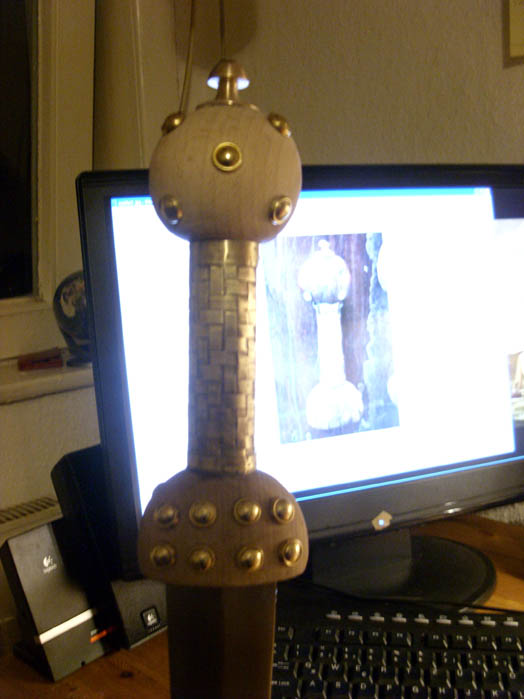
the rivets at the lower wood part on this image look not horizontal, but they are, don´t know...photo-perspective.
 Attachment: 95.57 KB Attachment: 95.57 KB
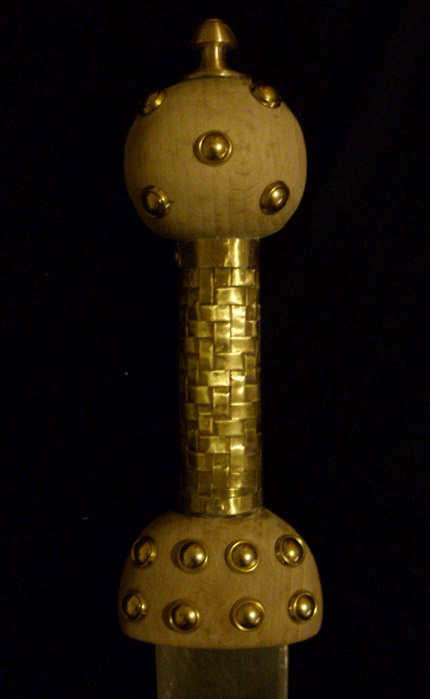
 Attachment: 87.13 KB Attachment: 87.13 KB
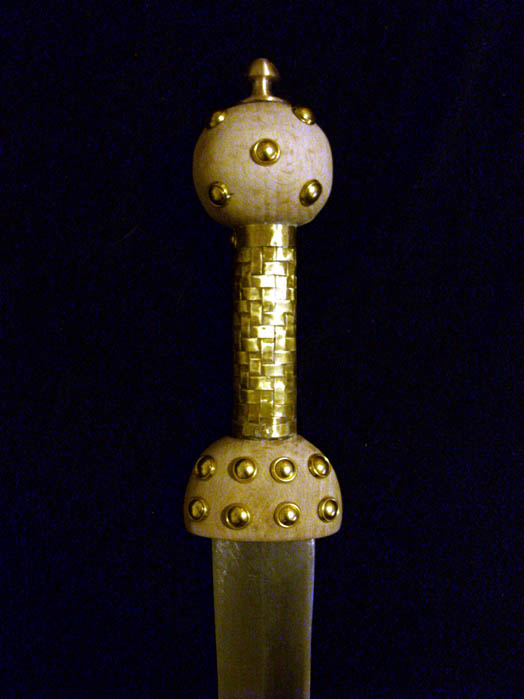
 Attachment: 88.26 KB Attachment: 88.26 KB
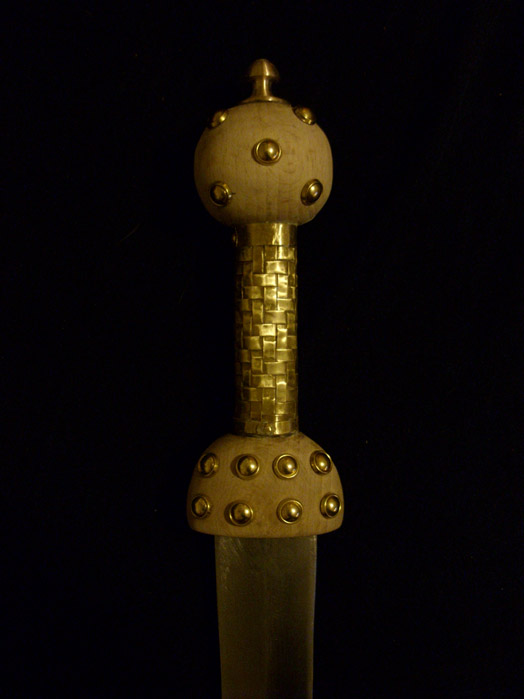
 Attachment: 84.44 KB Attachment: 84.44 KB
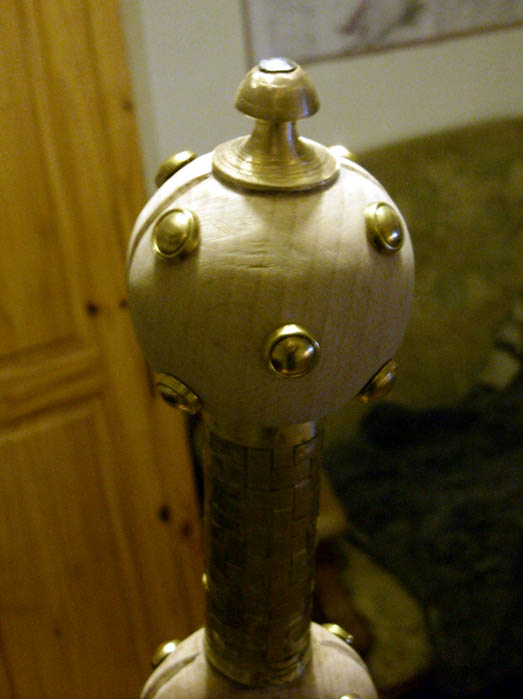
 Attachment: 90.57 KB Attachment: 90.57 KB
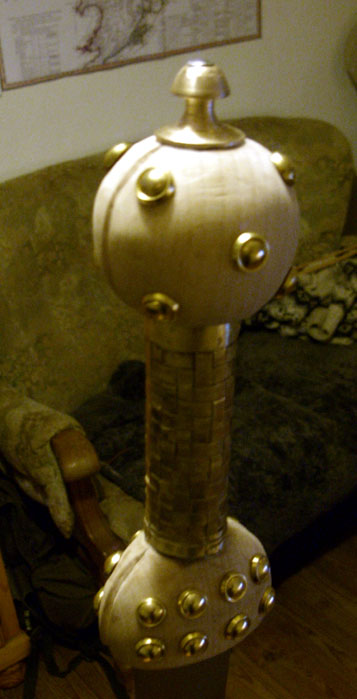
 Attachment: 97.88 KB Attachment: 97.88 KB
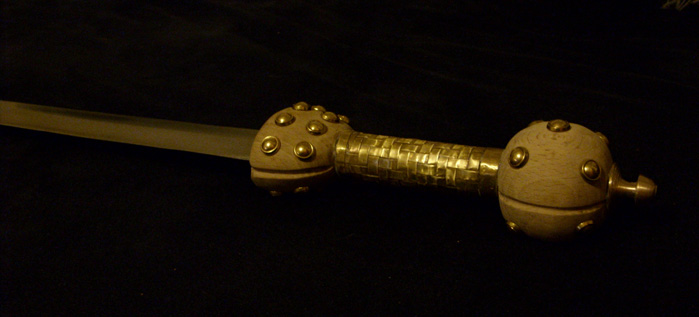
 Attachment: 112.1 KB Attachment: 112.1 KB
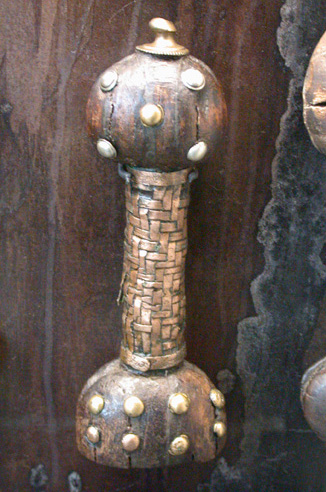
www.archaeoschmiede.de
www.eisenzeithaus.de
Last edited by Christian Böhling on Mon 22 Feb, 2010 12:23 pm; edited 1 time in total
|
|
   |
 |
|
Peter Johnsson
Industry Professional
|
 Posted: Mon 22 Feb, 2010 12:23 pm Post subject: Posted: Mon 22 Feb, 2010 12:23 pm Post subject: |
 |
|
Nice work Christian.
Brings a smile to my face.
I have this impression that the germanic hilts often had a thin leather cover over the pommel and guard (and grip in those cases when it was just wood). These nails are spaced over the surface in a way that it seems like an intention to distribute the stress of keeping leather taut over the surface. The deeply cut groves in the direction of the edge also seem perfect to keep two halves of leather pressed down while the leather cures.
(Perhaps even roman sword hilts were finished like this, in those cases when only wood was used?)
The leather would have been of a thin kind. Possibly gut leather. Since this type of leather was used to cover shields, it was a material and technique that was commonly in use. The transculent leather allows for coloring of the wood below the leather and the surface will take a wax or fat very readily, allowing effective proofing against wetness.
Just my private theory.
I know that no leather as survived, but that is also the case with the shields: no leather cover has survived. Tests has shown that a thin gut leather most probably have been used, even if no actual trace of the leather now survives. Edge bands around the rim of the shields would also have been effective in sealing the leather and keeping it in place. Sometimes also small holes as from stitching around the rim.
In the case of sword hilts we have the plentiful use of rivets and domed tacks, plus otherwise mysterious semi-circle shaped narrow iron bands along the edge of pommels and guards.
What do you think of this theory?
|
|
   |
 |
|
Christian Böhling
Industry Professional
|
 Posted: Mon 22 Feb, 2010 12:31 pm Post subject: Posted: Mon 22 Feb, 2010 12:31 pm Post subject: |
 |
|
Yes, Peter, I am with you in this theory!! At first I wanted to do with leather, but I made it as the original has survived, tried to not interprete too much here....but the next (and I will do this one again in Summer!) will be with leather, so that the Chasuari can discuss it with the public at their public gigs and explain experimental archaeology then! This is my plan - first one without interpretation, second with suggestions. And I believe in leather, too! So this example is a "know" one, next will be a "believe" one. And these will be the names of this swords: "Know" and "believe". Have to search for the germanic words for it. 
But I think I met the proportions exept the rivets are a bit too big...
EDIT: When I first thought at doing this with leather, I made a few trials and I was not very satisfied with it. We have all different leather types here at our ironage-house, well natural made and some thin and stretchable, but it was not easy to get it covering the pommel in a way we would like  I have to do other experiments. But now and without it gives a good impression of the original hilt from Thorsbjerg Mose as it repeats the woven brass cover and the rivets and the proportions - thats waht this is about. BTW: this seems to be the only brass woven hilt, and to decide me to make this piece has a story: I have to do other experiments. But now and without it gives a good impression of the original hilt from Thorsbjerg Mose as it repeats the woven brass cover and the rivets and the proportions - thats waht this is about. BTW: this seems to be the only brass woven hilt, and to decide me to make this piece has a story:
There is a woman in the Chasuari Group who is very much inside weaving and dying techniques. She is the expert in cloth. And she is a colleque of mine at my work. When she asked me to do early 3rd century stuff for her, I immediately decided to make the Thorsberg piece because of it´s woven brass cover. I saw that the original craftsman had make some mistakes (as he tried to keep one pattern). I decided to take the pattern of the middle of the grip and keep it at the whole rest the same... Will do te scabbard tomorrow and tomorrow evening she will get her Sword.
It is made of C60 Steel and very light. She will love it!
Cheers
Chris
www.archaeoschmiede.de
www.eisenzeithaus.de
|
|
   |
 |
Petr Florianek
Industry Professional

|
 Posted: Fri 26 Feb, 2010 11:04 pm Post subject: Posted: Fri 26 Feb, 2010 11:04 pm Post subject: |
 |
|
|
so do I, christian!
|
|
   |
 |
|
Michael Pikula
Industry Professional
|
 Posted: Sat 27 Feb, 2010 7:15 am Post subject: Posted: Sat 27 Feb, 2010 7:15 am Post subject: |
 |
|
Getting the leather to seat properly over the rounded surface can be a tricky task, but I was able to stretch leather over the bottom of a seax handle that had a domed bottom that was slightly rectangular. I used a similar groove as the one seen in your pommel to secure the leather with a piece of cord while working the wrinkles out of the leather. I think technically speaking the pommel shape and groove include all the component to ease the process of applying the leather. It would be interesting to know what, if anything, was placed inside of the grooves since that is where the two edges of the leather would come together. In my case I inserted a twisted wire and got a fairly clean look.
Very nice job on the hilt and the overall blade  I've really enjoyed this thread and seeing your work! I've really enjoyed this thread and seeing your work!
 Attachment: 5.36 KB Attachment: 5.36 KB
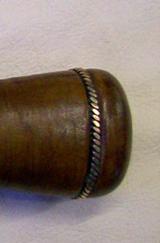
|
|
   |
 |
|
Christian Böhling
Industry Professional
|
 Posted: Sat 27 Feb, 2010 8:44 am Post subject: Posted: Sat 27 Feb, 2010 8:44 am Post subject: |
 |
|
| Michael Pikula wrote: | | I think technically speaking the pommel shape and groove include all the component to ease the process of applying the leather. It would be interesting to know what, if anything, was placed inside of the grooves since that is where the two edges of the leather would come together. |
That is the question!! Could have been an iron ring, because the iron dissapeared in the Thorsberg-bog, same happened to the sword-blades there. So iron would be a reasonable possibility! Only the grooves could have survived of it....BUT: There are also such pommels without grooves but with similair rivets! ....and: you would in such cases see a speciality at the bottom of the brass pommeI-crown (don´t know the right word for it, the brass piece where the tang-end is peened over) or at the top of the pommel, where the iron ring must have been devided to let the tang go through. Same at the top of the guard and the bottom of the hilt. If not the wire had passed through the hilt-hole alongside the tang and surrounding the pommel to get back down alongside the tang to finally surround the guard to be finally fixed between the shoulders of the blade and the guard (which I think is possible). Nevertheless: I like it without leather also!
Maybe they used the leather of Auroch´s bollocks, applied it wet and bloody, put the wood with the bullock-cover in the oak-and-peat pit for a year and let it dry again..... no, just joking 
But: I finished the scabbard today, will show images tomorrow evening together with the sword....
www.archaeoschmiede.de
www.eisenzeithaus.de
|
|
   |
 |
|
Peter Johnsson
Industry Professional
|
 Posted: Sat 27 Feb, 2010 9:51 am Post subject: Posted: Sat 27 Feb, 2010 9:51 am Post subject: |
 |
|
I think that leather cover may have been common, but I think not universal.
I also think that the grove was used for the two edges of leather to meet in a handy way and as a secure place to keep a cord while the glue and leather dried. As it has set, you do not really need something in the grove. The imprint of the cord will look like some of the press blech decorations you see i in those pommels and guards that are made in silver/bronze.
SOme hilts have those narrow strips of iron sheet metal fastened down with small tacks. They are another version of solution to this problem of keeping the leather in place and wrinkle free.
Some more experiments with reconstructions will give us more ideas, I´m sure!
|
|
   |
 |
|
Peter Johnsson
Industry Professional
|
 Posted: Sat 27 Feb, 2010 12:06 pm Post subject: Posted: Sat 27 Feb, 2010 12:06 pm Post subject: |
 |
|
| Christian Böhling wrote: |
.....
Maybe they used the leather of Auroch´s bollocks, applied it wet and bloody, put the wood with the bullock-cover in the oak-and-peat pit for a year and let it dry again..... no, just joking 
.... |
Christian, I have actually thought about this as well!
The "pouch" from bulls or he goats would fit the bill very well!
It was used for small bags, was it not?
Otherwise I´d put my money on gut leather, as raw hide, no tanning.
And, I am looking forward to seeing that sword complete with scabbard :-)
|
|
   |
 |
|
Christian Böhling
Industry Professional
|
 Posted: Sat 27 Feb, 2010 12:25 pm Post subject: Posted: Sat 27 Feb, 2010 12:25 pm Post subject: |
 |
|
| Peter Johnsson wrote: | | Christian Böhling wrote: |
.....
Maybe they used the leather of Auroch´s bollocks, applied it wet and bloody, put the wood with the bullock-cover in the oak-and-peat pit for a year and let it dry again..... no, just joking 
.... |
Christian, I have actually thought about this as well!
The "pouch" from bulls or he goats would fit the bill very well!
|
To all TOUCHY boys and girls out there:
This is the reason why "normal" people call us mad, WE ARE NOT, WE ARE TOTALLY INSANE!!! 
www.archaeoschmiede.de
www.eisenzeithaus.de
|
|
   |
 |
Maurizio D'Angelo

|
 Posted: Sun 28 Feb, 2010 6:43 pm Post subject: Posted: Sun 28 Feb, 2010 6:43 pm Post subject: |
 |
|
| Petr Florianek wrote: | Hello gentlemen!
I would like to replikate or craft item inspired by the find, which is now in Schleswik museum. Its not my usual interest period so i am little confused. Could you chime in and advice few things?
1) whats the dating, i assume 2nd century AD, but i dont know
2)what kind of blade? lenticular? diamond? welded edges? san mai? or just wrought? is it possible
3)Does the scabbard match?
thanks in advance! |
...An interesting feature of this hilt is its grip, which is covered with free
bronze thread intricately braided (fig. 37) which is well worth noting since it is a form of gripcovering
which was popular in the late seventeenth century and the early eighteenth. We shall find,
too, that there are mediaeval monuments which show sword grips similarly treated, though with
what material the carved stone gives no clue. We have always assumed that the interlacing patterns
were formed by flat leather ribbons; maybe we were wrong. At Thorsbjerg 37 Roman coins were
found; the earliest of Nero, A.D. 60, and the latest of Septimus Severus, A.D. 194....
from the book: Arm and armor from Prehistory pag 110
a sword is very similar to Pompei (southern Italy) 24 agust 79 A.D. Vesuvius erupted.
 Attachment: 22.11 KB Attachment: 22.11 KB

Ciao
Maurizio
|
|
   |
 |
|
Christian Böhling
Industry Professional
|
 Posted: Mon 01 Mar, 2010 4:26 am Post subject: Posted: Mon 01 Mar, 2010 4:26 am Post subject: |
 |
|
Now the finished piece with scabbard. Don´t mind the bad quality of the pics, try to get some better next days. My camera seems to deform the image if I take photos from direct above, but believe me, the blade is straight and the shadows does not apprear on the surface of the blade  . Seeing the pics, it looks like if the scabbard mouth was narrower than the scabbard itself: IT IS NOT! It is a very bad picture.....When I have my better camera I will visit the new owner to take good photos so that you can see it in the real appearance... . Seeing the pics, it looks like if the scabbard mouth was narrower than the scabbard itself: IT IS NOT! It is a very bad picture.....When I have my better camera I will visit the new owner to take good photos so that you can see it in the real appearance...
 Attachment: 99.91 KB Attachment: 99.91 KB

Bronce parts showing all details of the original. Will make better pics next days...
 Attachment: 98.58 KB Attachment: 98.58 KB

 Attachment: 112.1 KB Attachment: 112.1 KB
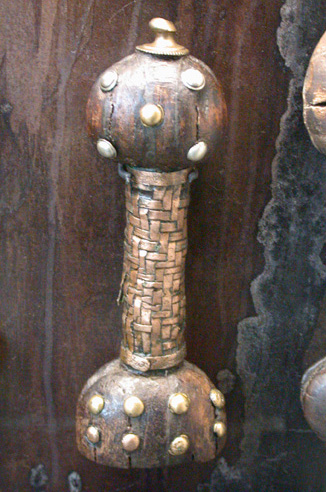
 Attachment: 52.12 KB Attachment: 52.12 KB
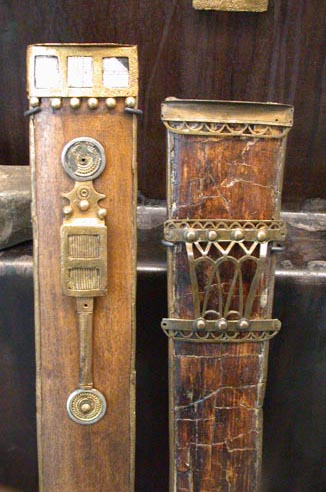
 Attachment: 102.52 KB Attachment: 102.52 KB
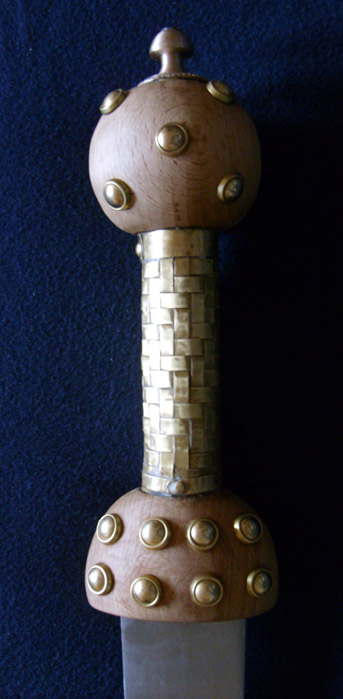
This pic shows the hilt before it was finished with bee´s wax, looks much better now.
www.archaeoschmiede.de
www.eisenzeithaus.de
Last edited by Christian Böhling on Mon 01 Mar, 2010 6:55 am; edited 1 time in total
|
|
   |
 |
|
Christian Böhling
Industry Professional
|
 Posted: Mon 01 Mar, 2010 4:37 am Post subject: Posted: Mon 01 Mar, 2010 4:37 am Post subject: |
 |
|
| Maurizio D'Angelo wrote: |
...An interesting feature of this hilt is its grip, which is covered with free
bronze thread intricately braided (fig. 37) which is well worth noting since it is a form of gripcovering
which was popular in the late seventeenth century and the early eighteenth. We shall find,
too, that there are mediaeval monuments which show sword grips similarly treated, though with
what material the carved stone gives no clue. We have always assumed that the interlacing patterns
were formed by flat leather ribbons; maybe we were wrong. At Thorsbjerg 37 Roman coins were
found; the earliest of Nero, A.D. 60, and the latest of Septimus Severus, A.D. 194....
from the book: Arm and armor from Prehistory pag 110
a sword is very similar to Pompei (southern Italy) 24 agust 79 A.D. Vesuvius erupted. |
Have a look at the whole thread in "Iron Age Crafts" you can see a small making of the woven grip... Among the bog finds of southern Scandinavia and northern Germany this woven grip is unique. I wondered if such a brass weaving would be uncomfortable in hand but it is not! The brass strips do not cut in the skin if woven round without a seam. I must say that it feels really good in hand, and not "slippy". It gives you a save feeling while handling the sword...
Cheers
Chris
www.archaeoschmiede.de
www.eisenzeithaus.de
|
|
   |
 |
Maurizio D'Angelo

|
 Posted: Mon 01 Mar, 2010 3:23 pm Post subject: Posted: Mon 01 Mar, 2010 3:23 pm Post subject: |
 |
|
I have to correct my information on the Spatha of Pompeii.
The error comes from here: (same book)
"There is also the hilt of a Roman sword, similar to one found in Pompeii and another (in the British
Museum) found in England. An interesting feature of this hilt is its grip, Which is covered with free
bronze intricately braided thread (Fig. 37) which is well worth noting since it is a form of gripcovering
which was popular in the late seventeenth century and the early eighteenth. We shall find,
too, that there are mediaeval monuments Which show sword grips similarly treated though with
what material the carved stone gives no clue. We have always assumed that the interlacing patterns
were formed by flat leather ribbons; maybe we were wrong. At Thorsbjerg 37 Roman coins were
found; the earliest of Nero, A.D. 60, and the latest of Septimus Severus, A.D. 194.... "
Fig. 37 refers to the same sword which is discussed here.
the hilt mentioned at the beginning refers to other swords.
I checked, there is no grip interlaced with bronze in Pompei.
Ciao
Maurizio
|
|
   |
 |
|
|
You cannot post new topics in this forum
You cannot reply to topics in this forum
You cannot edit your posts in this forum
You cannot delete your posts in this forum
You cannot vote in polls in this forum
You cannot attach files in this forum
You can download files in this forum
|
All contents © Copyright 2003-2024 myArmoury.com — All rights reserved
Discussion forums powered by phpBB © The phpBB Group
Switch to the Basic Low-bandwidth Version of the forum
|

